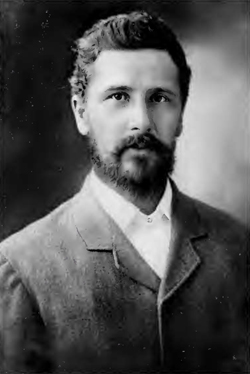
Council of Heads of Australasian Herbaria
Australian National Herbarium
Biographical Notes
 |
Council of Heads of Australasian Herbaria |
 Simmonds, John Howard [Snr] (1862 - 1955)
Simmonds, John Howard [Snr] (1862 - 1955)He was born 15 July 1862 in Carlton, Victoria, and
died 11 June 1955 in Brisbane.
He represented the third generation of
a family of stonemasons.
At the age of
18 years he was apprenticed to his father. Upon the death of his father in 1889, he (at 27 years old) took over the business
and continued to operate the company under
its original name and the
business only ceased operating with his retirement
in 1920 at the age of 58.
A characteristic feature of many
of his work is the carvings of garlands
of flowers, a somewhat signature style that
set him apart from other stonemasons then
working in Brisbane.
He married English-born Rose Culpin
(1877-1960) in 1900, and they had two sons,
John Howard (Jack) Simmonds (1901-1992) and Millice Alan Simmonds (1905-1983).
It appears that Simmonds (Snr) first took an interest
in geology and botany in the early 1880s
when he began to collect fossil specimens in
the Ipswich area and established a personal
collection. He also began to make donations
to the Queensland Museum at that time.
He
was a founding member of the Royal Society
of Queensland [RSQ] which was established
in 1884.
This placed him in
contact with scientists such as Frederick
Manson Bailey (botanist), John Frederick
Bailey (botanist), Thomas Lane Bancroft
(naturalist), Lewis Adolphus Bernays (economic botanist), Charles Walter de Vis
(zoologist), Robert Logan Jack (geologist),
Joseph Lauterer (botanist), John Shirley
(lichenologist and botanist) and Henry Tryon
(entomologist) amongst others.
He was appointed as a Committee Member at the first meeting of
the Field Naturalists' section within the
RSQ. At that time the Field
Naturalists' section was very active, and by
July 1887 had completed 19 field excursions
mostly as half or full day-trips within the
Brisbane region.
His greatest productivity as a
botanical collector was during his association
with the RSQ. However, many specimens
collected during the excursions were simply
labelled as the 'Field Naturalists' without
reference to individuals, and such specimens
cannot be included unquestionably among
his collections.
His membership
of the RSQ lapsed between 1903 and 1923,
but he re-joined in 1924 (along with his son, John Howard Simmonds [Jnr]),
and remained in continuous membership
until his death in 1955.
He is commemorated in the plants Ficus
simmondsii F.M.Bailey [= Ficus watkinsiana F.M.Bailey], Liparis simmondsii F.M.Bailey
[= Diteilis simmondsii (F.M.Bailey)
M.A.Clem. & D.L.Jones] and Psychotria
simmondsiana F.M.Bailey; the liverwort
Frullania simmondsii Steph.; the fossil plants
Araucarioxylon simmondsii Shirley, Ginkgo
simmondsii Shirley [= Ginkgoites simmondsii
(Shirley) Florin], and Stachyopitys simmondsii
Shirley [= Umkomasia simmondsii Shirley];
and the fossil beetle genus Simmondsia
Dunstan.
Herbarium specimens
Because Simmonds (Snr), his son Simmonds (Jnr,) had the same surname ane initials, and his wife Rose Simmonds collected as "Mrs J.H. Simmonds" using her husband's initials, there is much confusion as to individual collectors. Over 2,000 specimens are known as being collected by "Simmonds, J.H." and the paper by Dowe (2017), [LINK], attempts to analyse these collections.
Source: Extracted from:
Dowe, John Leslie (2017).
A family's contribution to Queensland botany: John Howard Simmonds
[Snr] (1862-1955), Rose Simmonds [née Culpin] (1877-1960) and John Howard Simmons [Jnr] (1901-1992).
Austrobaileya 10(1): 168-183.
Portrait Photo: as above.